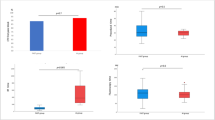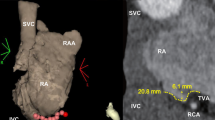Abstract
Objectives
We aimed to test the maximum voltage-guided cavotricuspid isthmus (CTI) ablation technique during ongoing atrial flutter.
Background
Former pathological and electrophysiological studies clarified that the cavotricuspid isthmus is composed of distinct muscular bundles, which are responsible for the conduction of electrical activation. Based on this observation, a maximum voltage-guided ablation technique (MVGT) was developed. This technique was assessed during pacing from the coronary sinus and was reported to be a feasible method to reach bidirectional isthmus block without the need for a complete anatomic ablation line.
Methods
This was a prospective, randomized single center study. Twenty patients underwent CTI ablation during atrial flutter. In group I (10 pts) CTI ablation was performed with complete anatomical ablation line. In group II (10 pts) ablation was guided by the highest amplitude potentials on the CTI sequentially until bidirectional isthmus block was reached. The following parameters were compared: acute success rate, procedure time, fluoroscopy time, number of radiofrequency (RF) applications and total RF duration.
Results
In all patients, atrial flutter terminated during ablation. Bidirectional isthmus block could be achieved in all pts. Procedure time was shorter in group II (107 ± 40 vs 68 ± 19 min, p < 0.01). Significantly less fluoroscopy was used in group II (22.6 ± 10.6 vs 12.1 ± 3.8 min, p < 0.01). There were less RF applications in group II (27.1 ± 21.5 vs 5.9 ± 2.4, p < 0.001).
Conclusions
(1) The major finding of this study is that MVGT is a feasible method even during ongoing atrial flutter. (2) Our data confirm that MVGT is an effective technique for CTI ablation with considerable decrease in procedure and fluoroscopy times.
Similar content being viewed by others
References
Natale, A., Newby, K. H., Pisanó, E., Leonelli, F., Fanelli, R., Potenza, D., et al. (2000). Prospective randomized comparison of antiarrhythmic therapy versus first-line radiofrequency ablation in patients with atrial flutter. Journal of the American College of Cardiology, 35, 1898–1904.
Shah, D. C., Haissaguerre, M., Jais, P., Fischer, B., Takahashi, A., Hocini, M., et al. (1997). Simplified electrophysiologically directed catheter ablation of recurrent common atrial flutter. Circulation, 26, 2505–2508.
Poty, H., Saoudi, N., Haïssaguerre, M., Daou, A., Clémenty, J., & Letac, B. (1996). Radiofrequency catheter ablation of atrial tachycardias. American Heart Journal, 131, 481–489.
Cosio, F. G., Lopez, G. M., Arribas, F., & Golcolea, A. (1993). Radiofrequency catheter ablation for the treatment of human type I atrial flutter. Circulation, 88, 804–805.
Kirkorian, G., Moncada, E., Chevalier, P., Canu, G., Claudel, J. P., Bellon, C., et al. (1994). Radiofrequency ablation of atrial flutter. Efficacy of an anatomically guided approach. Circulation, 90, 2804–2814.
Takahashi, A., Shah, D. C., Jais, P., & Haissaguerre, M. (1999). How to ablate typical atrial flutter. Europace, 1, 151–155.
Cabrera, J. A., Sanchez-Quintana, D., Farre, J., Rubio, J. M., & Ho, S. Y. (2005). The inferior right atrial isthmus: Further architectural insights for current and coming ablation technologies. Journal of Cardiovascuclar Electrophysiology, 16, 402–408.
DaCosta, A., Faure, E., & Thevenin, J. (2004). Effect of isthmus anatomy and ablation catheter on radiofrequency catheter ablation of the cavotricuspid isthmus. ACC Current Journal Review, 13, 43–44.
Okishige, K., Kawabata, M., Yamashiro, K., Ohsiro, C., Umayahara, S., Gotoh, M., et al. (2005). Clinical study regarding the anatomical structures of the right atrial isthmus using intra-cardiac echocardiography; Implication for catheter ablation of common atrial flutter. Journal of Interventional Cardiac Electrophysiology, 12, 9–12.
Ozaydin, M., Tada, H., Chugh, A., Scharf, C., Lai, S. W., Pelosi F., Jr., et al. (2003). Atrial electrogram amplitude and efficacy of cavotricuspid isthmus ablation for atrial flutter. Pacing and Clinical Electrophysiology, 26, 1859–1863.
Redfearn, D. P., Skanes, A. C., Gula, L. J., Krahn, A. D., Yee, R., & Klein, G. J. (2006). Cavotricuspid isthmus conduction is dependent on underlying anatomic bundle architecture: Observations using a maximum voltage-guided ablation technique. Journal of Cardiovascular Electrophysiology, 17, 832–838.
Hall, B., Veerareddy, S., Cheung, P., Good, E., Lemola, K., Han, J., et al. (2004). Randomized comparison of anatomical versus voltage guided ablation of the cavotricuspid isthmus for atrial flutter. Heart Rhythm, 1, 43–48.
Schulte, B., Sperzel, J., Schwarz, T., Pitschner, H. F., Strupp, G., & Neuzner, J. (2000). Detection of ventricular fibrillation in implantable defibrillators with automatic gain control amplifiers. Europace, 2, 160–162.
Leitch, J. W., Yee, R., Klein, G. J., Jones, D. L., & Murdock, J. C. (1990). Correlation between the ventricular electrogram amplitude in sinus rhythm and in ventricular fibrillation. Pacing and Clinical Electrophysiology, 13, 1105–1109.
Sperry, R. E., Ellenbogen, K. A., Wood, M. A., Stambler, B. S., DiMarco, J. P., & Haines, D. E. (1992). Failure of a second and third generation implantable cardioverter defibrillator to sense ventricular tachycardia: Implications for fix-gain sensing devices. Pacing and Clinical Electrophysiology, 15, 749–755.
Subbiah, R. N., Gula, L. J., Krahn, A. D., Posan, E., Yee, R., Klein, G. J., et al. (2007). Rapid ablation for atrial flutter, by targeting maximum voltage factors associated with short ablation times. Journal of Cardiovascular Electrophysiology, 18, 612–616.
Shah, D. C., Takahashi, A., Jais, P., Hocini, M., Clemety, J., & Haissaguerre, M. (1999). Local electrogram-based criteria of cavotricuspid isthmus block. Journal of Cardiovascular Electrophysiology, 10, 662–669.
Sasano, T., & Okishige, K. (2002). Clinical implication of the double potentials at the cavotricuspid isthmus for radiofrequency catheter ablation of typical atrial flutter. Journal of Electrocardiology, 35, 321–326.
Tada, H., Oral, H., Ozaydin, M., Chugh, A., Scharf, C., Hassan, S., et al. (2002). Randomized comparison of anatomic and electrogram mapping approaches to ablation of typical atrial flutter. Journal of Cardiovascular Electrophysiology, 13, 662–666.
Posan, E., Redfearn, D. P., Gula, L. J., Krahn, A. D., Yee, R., Klein, G. J., et al. (2007). Elimination of cavotricuspid isthmus conduction by a single ablation lesion: Observations from a maximum voltage-guided ablation technique. Europace, 9, 208–211.
Montenero, A. S., Bruno, N., Antonelli, A., Mangiameli, D., Barbieri, L., Andrew, P., et al. (2005). Long-term efficacy of cryo catheter ablation for the treatment of atrial flutter. Journal of the American College of Cardiology, 45, 573–580.
Marrouche, N. F., Schweikert, R., Saliba, W., Pavia, S. V., Martin, D. O., Dresing, T., et al. (2003). Use of different catheter ablation technologies for treatment of typical atrial flutter: Acute results and long-term follow-up. Pacing and Clinical Electrophysiology, 26, 743–746.
Author information
Authors and Affiliations
Corresponding author
Rights and permissions
About this article
Cite this article
Bauernfeind, T., Kardos, A., Foldesi, C. et al. Assessment of the maximum voltage-guided technique for cavotricuspid isthmus ablation during ongoing atrial flutter. J Interv Card Electrophysiol 19, 195–199 (2007). https://doi.org/10.1007/s10840-007-9158-1
Received:
Accepted:
Published:
Issue Date:
DOI: https://doi.org/10.1007/s10840-007-9158-1




